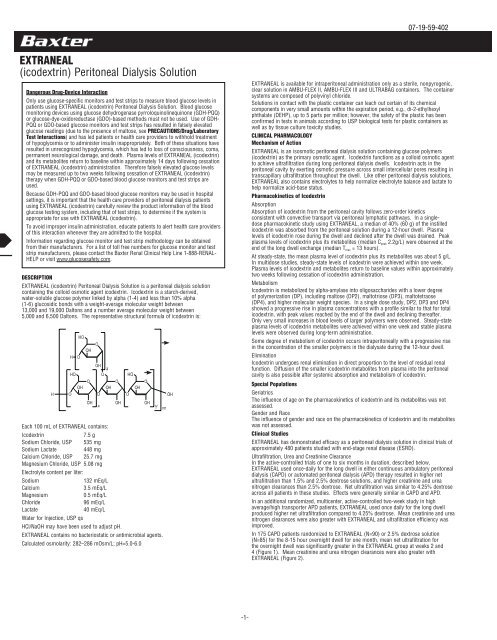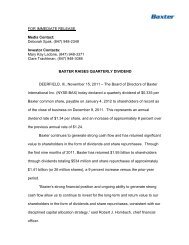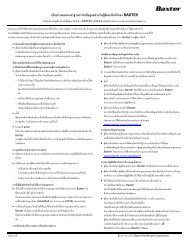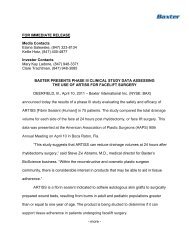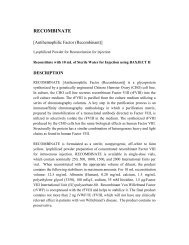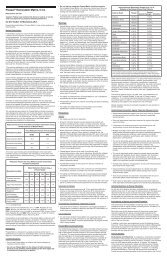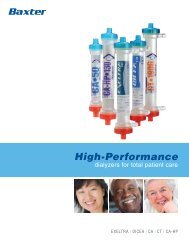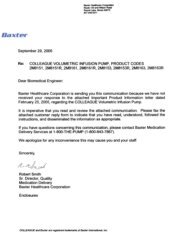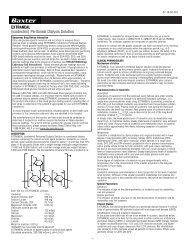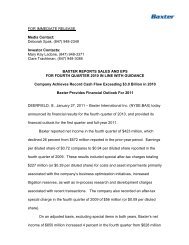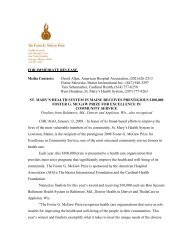EXTRANEAL (icodextrin) Peritoneal Dialysis Solution - Baxter
EXTRANEAL (icodextrin) Peritoneal Dialysis Solution - Baxter
EXTRANEAL (icodextrin) Peritoneal Dialysis Solution - Baxter
Create successful ePaper yourself
Turn your PDF publications into a flip-book with our unique Google optimized e-Paper software.
<strong>EXTRANEAL</strong><br />
(<strong>icodextrin</strong>) <strong>Peritoneal</strong> <strong>Dialysis</strong> <strong>Solution</strong><br />
Dangerous Drug-Device Interaction<br />
Only use glucose-specific monitors and test strips to measure blood glucose levels in<br />
patients using <strong>EXTRANEAL</strong> (<strong>icodextrin</strong>) <strong>Peritoneal</strong> <strong>Dialysis</strong> <strong>Solution</strong>. Blood glucose<br />
monitoring devices using glucose dehydrogenase pyrroloquinolinequinone (GDH-PQQ)<br />
or glucose-dye-oxidoreductase (GDO)-based methods must not be used. Use of GDH-<br />
PQQ or GDO-based glucose monitors and test strips has resulted in falsely elevated<br />
glucose readings (due to the presence of maltose, see PRECAUTIONS/Drug/Laboratory<br />
Test Interactions) and has led patients or health care providers to withhold treatment<br />
of hypoglycemia or to administer insulin inappropriately. Both of these situations have<br />
resulted in unrecognized hypoglycemia, which has led to loss of consciousness, coma,<br />
permanent neurological damage, and death. Plasma levels of <strong>EXTRANEAL</strong> (<strong>icodextrin</strong>)<br />
and its metabolites return to baseline within approximately 14 days following cessation<br />
of <strong>EXTRANEAL</strong> (<strong>icodextrin</strong>) administration. Therefore falsely elevated glucose levels<br />
may be measured up to two weeks following cessation of <strong>EXTRANEAL</strong> (<strong>icodextrin</strong>)<br />
therapy when GDH-PQQ or GDO-based blood glucose monitors and test strips are<br />
used.<br />
Because GDH-PQQ and GDO-based blood glucose monitors may be used in hospital<br />
settings, it is important that the health care providers of peritoneal dialysis patients<br />
using <strong>EXTRANEAL</strong> (<strong>icodextrin</strong>) carefully review the product information of the blood<br />
glucose testing system, including that of test strips, to determine if the system is<br />
appropriate for use with <strong>EXTRANEAL</strong> (<strong>icodextrin</strong>).<br />
To avoid improper insulin administration, educate patients to alert health care providers<br />
of this interaction whenever they are admitted to the hospital.<br />
Information regarding glucose monitor and test strip methodology can be obtained<br />
from their manufacturers. For a list of toll free numbers for glucose monitor and test<br />
strip manufacturers, please contact the <strong>Baxter</strong> Renal Clinical Help Line 1-888-RENAL-<br />
HELP or visit www.glucosesafety.com.<br />
DESCRIPTION<br />
<strong>EXTRANEAL</strong> (<strong>icodextrin</strong>) <strong>Peritoneal</strong> <strong>Dialysis</strong> <strong>Solution</strong> is a peritoneal dialysis solution<br />
containing the colloid osmotic agent <strong>icodextrin</strong>. Icodextrin is a starch-derived,<br />
water-soluble glucose polymer linked by alpha (1-4) and less than 10% alpha<br />
(1-6) glucosidic bonds with a weight-average molecular weight between<br />
13,000 and 19,000 Daltons and a number average molecular weight between<br />
5,000 and 6,500 Daltons. The representative structural formula of <strong>icodextrin</strong> is:<br />
Each 100 mL of <strong>EXTRANEAL</strong> contains:<br />
Icodextrin 7.5 g<br />
Sodium Chloride, USP 535 mg<br />
Sodium Lactate 448 mg<br />
Calcium Chloride, USP 25.7 mg<br />
Magnesium Chloride, USP 5.08 mg<br />
Electrolyte content per liter:<br />
Sodium 132 mEq/L<br />
Calcium 3.5 mEq/L<br />
Magnesium 0.5 mEq/L<br />
Chloride 96 mEq/L<br />
Lactate 40 mEq/L<br />
Water for Injection, USP qs<br />
HCl/NaOH may have been used to adjust pH.<br />
<strong>EXTRANEAL</strong> contains no bacteriostatic or antimicrobial agents.<br />
Calculated osmolarity: 282–286 mOsm/L; pH=5.0-6.0<br />
-1-<br />
07-19-59-402<br />
<strong>EXTRANEAL</strong> is available for intraperitoneal administration only as a sterile, nonpyrogenic,<br />
clear solution in AMBU-FLEX II, AMBU-FLEX III and ULTRABAG containers. The container<br />
systems are composed of polyvinyl chloride.<br />
<strong>Solution</strong>s in contact with the plastic container can leach out certain of its chemical<br />
components in very small amounts within the expiration period, e.g., di-2-ethylhexyl<br />
phthalate (DEHP), up to 5 parts per million; however, the safety of the plastic has been<br />
confirmed in tests in animals according to USP biological tests for plastic containers as<br />
well as by tissue culture toxicity studies.<br />
CLINICAL PHARMACOLOGY<br />
Mechanism of Action<br />
<strong>EXTRANEAL</strong> is an isosmotic peritoneal dialysis solution containing glucose polymers<br />
(<strong>icodextrin</strong>) as the primary osmotic agent. Icodextrin functions as a colloid osmotic agent<br />
to achieve ultrafiltration during long peritoneal dialysis dwells. Icodextrin acts in the<br />
peritoneal cavity by exerting osmotic pressure across small intercellular pores resulting in<br />
transcapillary ultrafiltration throughout the dwell. Like other peritoneal dialysis solutions,<br />
<strong>EXTRANEAL</strong> also contains electrolytes to help normalize electrolyte balance and lactate to<br />
help normalize acid-base status.<br />
Pharmacokinetics of Icodextrin<br />
Absorption<br />
Absorption of <strong>icodextrin</strong> from the peritoneal cavity follows zero-order kinetics<br />
consistent with convective transport via peritoneal lymphatic pathways. In a singledose<br />
pharmacokinetic study using <strong>EXTRANEAL</strong>, a median of 40% (60 g) of the instilled<br />
<strong>icodextrin</strong> was absorbed from the peritoneal solution during a 12-hour dwell. Plasma<br />
levels of <strong>icodextrin</strong> rose during the dwell and declined after the dwell was drained. Peak<br />
plasma levels of <strong>icodextrin</strong> plus its metabolites (median Cpeak 2.2g/L) were observed at the<br />
end of the long dwell exchange (median Tmax = 13 hours).<br />
At steady-state, the mean plasma level of <strong>icodextrin</strong> plus its metabolites was about 5 g/L.<br />
In multidose studies, steady-state levels of <strong>icodextrin</strong> were achieved within one week.<br />
Plasma levels of <strong>icodextrin</strong> and metabolites return to baseline values within approximately<br />
two weeks following cessation of <strong>icodextrin</strong> administration.<br />
Metabolism<br />
Icodextrin is metabolized by alpha-amylase into oligosaccharides with a lower degree<br />
of polymerization (DP), including maltose (DP2), maltotriose (DP3), maltotetraose<br />
(DP4), and higher molecular weight species. In a single dose study, DP2, DP3 and DP4<br />
showed a progressive rise in plasma concentrations with a profile similar to that for total<br />
<strong>icodextrin</strong>, with peak values reached by the end of the dwell and declining thereafter.<br />
Only very small increases in blood levels of larger polymers were observed. Steady-state<br />
plasma levels of <strong>icodextrin</strong> metabolites were achieved within one week and stable plasma<br />
levels were observed during long-term administration.<br />
Some degree of metabolism of <strong>icodextrin</strong> occurs intraperitoneally with a progressive rise<br />
in the concentration of the smaller polymers in the dialysate during the 12-hour dwell.<br />
Elimination<br />
Icodextrin undergoes renal elimination in direct proportion to the level of residual renal<br />
function. Diffusion of the smaller <strong>icodextrin</strong> metabolites from plasma into the peritoneal<br />
cavity is also possible after systemic absorption and metabolism of <strong>icodextrin</strong>.<br />
Special Populations<br />
Geriatrics<br />
The influence of age on the pharmacokinetics of <strong>icodextrin</strong> and its metabolites was not<br />
assessed.<br />
Gender and Race<br />
The influence of gender and race on the pharmacokinetics of <strong>icodextrin</strong> and its metabolites<br />
was not assessed.<br />
Clinical Studies<br />
<strong>EXTRANEAL</strong> has demonstrated efficacy as a peritoneal dialysis solution in clinical trials of<br />
approximately 480 patients studied with end-stage renal disease (ESRD).<br />
Ultrafiltration, Urea and Creatinine Clearance<br />
In the active-controlled trials of one to six months in duration, described below,<br />
<strong>EXTRANEAL</strong> used once-daily for the long dwell in either continuous ambulatory peritoneal<br />
dialysis (CAPD) or automated peritoneal dialysis (APD) therapy resulted in higher net<br />
ultrafiltration than 1.5% and 2.5% dextrose solutions, and higher creatinine and urea<br />
nitrogen clearances than 2.5% dextrose. Net ultrafiltration was similar to 4.25% dextrose<br />
across all patients in these studies. Effects were generally similar in CAPD and APD.<br />
In an additional randomized, multicenter, active-controlled two-week study in high<br />
average/high transporter APD patients, <strong>EXTRANEAL</strong> used once daily for the long dwell<br />
produced higher net ultrafiltration compared to 4.25% dextrose. Mean creatinine and urea<br />
nitrogen clearances were also greater with <strong>EXTRANEAL</strong> and ultrafiltration efficiency was<br />
improved.<br />
In 175 CAPD patients randomized to <strong>EXTRANEAL</strong> (N=90) or 2.5% dextrose solution<br />
(N=85) for the 8-15 hour overnight dwell for one month, mean net ultrafiltration for<br />
the overnight dwell was significantly greater in the <strong>EXTRANEAL</strong> group at weeks 2 and<br />
4 (Figure 1). Mean creatinine and urea nitrogen clearances were also greater with<br />
<strong>EXTRANEAL</strong> (Figure 2).
Figure 1 - Mean Net Ultrafiltration for the Overnight Dwell<br />
Figure 2 – Mean Creatinine and Urea Nitrogen Clearance<br />
for the Overnight Dwell<br />
*p
Need for Trained Physician<br />
Treatment should be initiated and monitored under the supervision of a physician<br />
knowledgeable in the management of patients with renal failure.<br />
A patient’s volume status should be carefully monitored to avoid hyper- or hypovolemia and<br />
potentially severe consequences including congestive heart failure, volume depletion and<br />
hypovolemic shock. An accurate fluid balance record must be kept and the patient’s body<br />
weight monitored.<br />
Significant losses of protein, amino acids, water-soluble vitamins and other medicines may<br />
occur during peritoneal dialysis. The patient’s nutritional status should be monitored and<br />
replacement therapy should be provided as necessary.<br />
In patients with hypercalcemia, particularly in those on low-calcium peritoneal dialysis<br />
solutions, consideration should be given to the fact that <strong>EXTRANEAL</strong> is not provided in a<br />
low-calcium electrolyte solution.<br />
<strong>Solution</strong>s that are cloudy, contain particulate matter, or show evidence of leakage should not<br />
be used.<br />
Insulin-dependent diabetes mellitus<br />
Patients with insulin-dependent diabetes may require modification of insulin dosage following<br />
initiation of treatment with <strong>EXTRANEAL</strong>. Appropriate monitoring of blood glucose should<br />
be performed and insulin dosage adjusted if needed (See WARNINGS; PRECAUTIONS, Drug/<br />
Laboratory Test Interactions).<br />
Information for Patients<br />
Patients should be instructed not to use solutions if they are cloudy, discolored, contain<br />
visible particulate matter, or if they show evidence of leaking containers.<br />
Aseptic technique should be employed throughout the procedure.<br />
To reduce possible discomfort during administration, patients should be instructed that<br />
solutions may be warmed to 37°C (98°F) prior to use. Only dry heat should be used. It is<br />
best to warm solutions within the overwrap using a heating pad. To avoid contamination,<br />
solutions should not be immersed in water for warming. Do not use a microwave oven to<br />
warm <strong>EXTRANEAL</strong>. Heating the solution above 40°C (104°F) may be detrimental to the<br />
solution. (See DOSAGE AND ADMINISTRATION, Directions for Use).<br />
Because the use of <strong>EXTRANEAL</strong> interferes with glucose dehydrogenase<br />
pyrroloquinolinequinone (GDH-PQQ) and glucose-dye-oxidoreductase based blood<br />
glucose measurements, patients should be instructed to use only glucose-specific<br />
glucose monitors and test strips. (See WARNINGS; PRECAUTIONS, Drug/Laboratory Test<br />
Interactions).<br />
A Patient Medication Guide is provided in each carton of <strong>EXTRANEAL</strong>.<br />
Laboratory Tests<br />
Serum Electrolytes<br />
Decreases in serum sodium and chloride have been observed in patients using<br />
<strong>EXTRANEAL</strong>. The mean change in serum sodium from baseline to the last study visit was<br />
–2.8 mmol/L for patients on <strong>EXTRANEAL</strong> and –0.3 mmol/L for patients on control solution.<br />
Four <strong>EXTRANEAL</strong> patients and two control patients developed serum sodium < 125<br />
mmol/L. The mean change in serum chloride from baseline to last study visit was –2.0<br />
mmol/L for <strong>EXTRANEAL</strong> patients and + 0.6 mmol/L for control patients. Similar changes<br />
in serum chemistries were observed in an additional clinical study in a subpopulation<br />
of high average/high transporter patients. The declines in serum sodium and chloride<br />
may be related to dilution resulting from the presence of <strong>icodextrin</strong> metabolites in<br />
plasma. Although these decreases have been small and clinically unimportant, monitoring<br />
of the patients’ serum electrolyte levels as part of routine blood chemistry testing is<br />
recommended.<br />
<strong>EXTRANEAL</strong> does not contain potassium. Evaluate serum potassium prior to<br />
administering potassium chloride to the patient. In situations where there is a normal<br />
serum potassium level or hypokalemia, addition of potassium chloride (up to a<br />
concentration of 4 mEq/L of potassium) to the solution may be necessary to prevent<br />
severe hypokalemia. This should be made under careful evaluation of serum and total body<br />
potassium, only under the direction of a physician.<br />
Fluid, hematology, blood chemistry, electrolyte concentrations, and bicarbonate should be<br />
monitored periodically. If serum magnesium levels are low, magnesium supplements may<br />
be used.<br />
Alkaline Phosphatase<br />
An increase in mean serum alkaline phosphatase has been observed in clinical studies of<br />
ESRD patients receiving <strong>EXTRANEAL</strong>. No associated increases in liver function tests were<br />
observed. Serum alkaline phosphatase levels did not show evidence of progressive<br />
increase over a 12-month study period. Levels returned to normal approximately two<br />
weeks after discontinuation of <strong>EXTRANEAL</strong>.<br />
There were individual cases where increased alkaline phosphatase was associated with<br />
elevated AST (SGOT), but neither elevation was considered causally related to treatment.<br />
-3-<br />
Drug Interactions<br />
General<br />
No clinical drug interaction studies were performed. No evaluation of <strong>EXTRANEAL</strong>’s<br />
effects on the cytochrome P450 system was conducted. As with other dialysis solutions,<br />
blood concentrations of dialyzable drugs may be reduced by dialysis. Dosage adjustment<br />
of concomitant medications may be necessary. In patients using cardiac glycosides<br />
(digoxin and others), plasma levels of calcium, potassium and magnesium must be<br />
carefully monitored.<br />
Insulin<br />
A clinical study in 6 insulin-dependent diabetic patients demonstrated no effect of<br />
<strong>EXTRANEAL</strong> on insulin absorption from the peritoneal cavity or on insulin’s ability to<br />
control blood glucose when insulin was administered intraperitoneally with <strong>EXTRANEAL</strong>.<br />
However, appropriate monitoring (See PRECAUTIONS, Drug/Laboratory Test Interactions)<br />
of blood glucose should be performed when initiating <strong>EXTRANEAL</strong> in diabetic patients and<br />
insulin dosage should be adjusted if needed (See PRECAUTIONS).<br />
Heparin<br />
No human drug interaction studies with heparin were conducted. In vitro studies<br />
demonstrated no evidence of incompatibility of heparin with <strong>EXTRANEAL</strong>.<br />
Antibiotics<br />
No human drug interaction studies with antibiotics were conducted. In vitro studies<br />
evaluating the minimum inhibitory concentration (MIC) of vancomycin, cefazolin,<br />
ampicillin, ampicillin/flucoxacillin, ceftazidime, gentamicin, and amphotericin demonstrated<br />
no evidence of incompatibility of these antibiotics with <strong>EXTRANEAL</strong>. (See DOSAGE AND<br />
ADMINISTRATION)<br />
Drug/Laboratory Test Interactions<br />
Blood Glucose<br />
Blood glucose measurement must be done with a glucose-specific method to prevent<br />
maltose interference with test results. Since falsely elevated glucose levels have been<br />
observed with blood glucose monitoring devices and test strips that use glucose<br />
dehydrogenase pyrroloquinolinequinone (GDH PQQ) or glucose-dye-oxidoreductase based<br />
methods, GDH PQQ or glucose-dye-oxidoreductase based methods should not be used to<br />
measure glucose levels in patients administered <strong>EXTRANEAL</strong>. (See WARNINGS).<br />
Serum Amylase<br />
An apparent decrease in serum amylase activity has been observed in patients<br />
administered <strong>EXTRANEAL</strong>. Preliminary investigations indicate that <strong>icodextrin</strong> and its<br />
metabolites interfere with enzymatic-based amylase assays, resulting in inaccurately low<br />
values. This should be taken into account when evaluating serum amylase levels for<br />
diagnosis or monitoring of pancreatitis in patients using <strong>EXTRANEAL</strong>.<br />
Carcinogenesis, Mutagenesis, Impairment of Fertility<br />
Icodextrin did not demonstrate evidence of genotoxicity potential in in vitro bacterial cell<br />
reverse mutation assay (Ames test); in vitro mammalian cell chromosomal aberration<br />
assay (CHO cell assay); and in the in vivo micronucleus assay in rats. Long-term animal<br />
studies to evaluate the carcinogenic potential of <strong>EXTRANEAL</strong> or <strong>icodextrin</strong> have not been<br />
conducted. Icodextrin is derived from maltodextrin, a common food ingredient.<br />
A fertility study in rats where males and females were treated for four and two weeks,<br />
respectively, prior to mating and until day 17 of gestation at up to 1.5 g/kg/day (1/3 the<br />
human exposure on a mg/m2 basis) revealed slightly low epididymal weights in parental<br />
males in the high dose group as compared to Control. Toxicological significance of this<br />
finding was not evident as no other reproductive organs were affected and all males were<br />
of proven fertility. The study demonstrated no effects of treatment with <strong>icodextrin</strong> on<br />
mating performance, fertility, litter response, embryo-fetal survival, or fetal growth and<br />
development.<br />
Pregnancy<br />
Pregnancy Category C<br />
Complete animal reproduction studies including in utero embryofetal development at<br />
appreciable multiples of human exposure have not been conducted with <strong>EXTRANEAL</strong> or<br />
<strong>icodextrin</strong>. Thus it is not known whether <strong>icodextrin</strong> or <strong>EXTRANEAL</strong> solution can cause<br />
fetal harm when administered to a pregnant woman or affect reproductive capacity.<br />
<strong>EXTRANEAL</strong> should only be utilized in pregnant women when the need outweighs the<br />
potential risks.<br />
Nursing Mothers<br />
It is not known whether <strong>icodextrin</strong> or its metabolites are excreted in human milk. Because<br />
many drugs are excreted in human milk, caution should be exercised when <strong>EXTRANEAL</strong> is<br />
administered to a nursing woman.<br />
Pediatric Use<br />
Safety and effectiveness in pediatric patients have not been established.
Geriatric Use<br />
No formal studies were specifically carried out in the geriatric population. However, 140 of<br />
the patients in clinical studies of <strong>EXTRANEAL</strong> were age 65 or older, with 28 of the patients<br />
age 75 or older. No overall differences in safety or effectiveness were observed between<br />
these patients and patients under age 65. Although clinical experience has not identified<br />
differences in responses between the elderly and younger patients, greater sensitivity of<br />
some older individuals cannot be ruled out.<br />
ADVERSE REACTIONS<br />
Clinical Trials<br />
Because clinical trials are conducted under widely varying conditions, adverse reaction<br />
rates observed in clinical trials of a drug cannot be compared to rates in the clinical trials<br />
of another drug and may not reflect the rates observed in practice. The adverse reaction<br />
information from clinical trials does, however, provide a basis for identifying the adverse<br />
events that appear to be related to drug use and for approximating rates.<br />
<strong>EXTRANEAL</strong> was originally studied in controlled clinical trials of 493 patients with<br />
end-stage renal disease who received a single daily exchange of <strong>EXTRANEAL</strong> for the long<br />
dwell (8- to 16- hours). There were 215 patients exposed for at least 6 months and<br />
155 patients exposed for at least one year. The population was 18-83 years of age,<br />
56% male and 44% female, 73% Caucasian, 18% Black, 4% Asian, 3% Hispanic, and<br />
it included patients with the following comorbid conditions: 27% diabetes,<br />
49% hypertension and 23% hypertensive nephropathy.<br />
Rash was the most frequently occurring <strong>EXTRANEAL</strong>-related adverse event (5.5%,<br />
<strong>EXTRANEAL</strong>; 1.7% Control). Seven patients on <strong>EXTRANEAL</strong> discontinued treatment due to<br />
rash, and one patient on <strong>EXTRANEAL</strong> discontinued due to exfoliative dermatitis. The rash<br />
typically appeared within the first three weeks of treatment and resolved with treatment<br />
discontinuation or, in some patients, with continued treatment.<br />
Female patients reported a higher incidence of skin events, including rash, in both<br />
<strong>EXTRANEAL</strong> and dextrose control treatment groups.<br />
Table 1 shows the adverse events reported in these clinical studies, regardless of causality,<br />
occurring in ≥ 5% of patients and more common on <strong>EXTRANEAL</strong> than control.<br />
Adverse reactions reported with an incidence of > 5% and at least as common on<br />
dextrose control included pain, asthenia, exit site infection, infection, back pain,<br />
hypotension, diarrhea, vomiting, nausea/vomiting, anemia, peripheral edema, hypokalemia,<br />
hyperphosphatemia, hypoproteinemia, hypervolemia, arthralgia, dizziness, dyspnea, skin<br />
disorder, pruritis.<br />
Additional adverse events occurring at an incidence of < 5% and that may or may not<br />
have been related to <strong>EXTRANEAL</strong> include: pain on infusion, abdominal enlargement,<br />
cloudy effluent, ultrafiltration decrease, postural hypotension, heart failure, hyponatremia,<br />
hypochloremia, hypercalcemia, hypoglycemia, alkaline phosphatase increase, SGPT<br />
increase, SGOT increase, cramping, confusion, lung edema, facial edema, exfoliative<br />
dermatitis, eczema, vesicobullous rash, maculopapular rash, erythema multiforme. All<br />
reported events are included in the list except those already listed in Table 1 or the<br />
following two paragraphs, those not plausibly associated with <strong>EXTRANEAL</strong>, and those that<br />
were associated with the condition being treated or related to the dialysis procedure.<br />
<strong>EXTRANEAL</strong> was additionally studied in a subpopulation of 92 high average/high<br />
transporter APD patients in a two-week controlled clinical trial where patients received a<br />
single daily exchange of <strong>EXTRANEAL</strong> (n=47) or dextrose control (n=45) for the long dwell<br />
(14 ± 2 hours). Consistent with the data reported in the original trials of <strong>EXTRANEAL</strong>, rash<br />
was the most frequently occurring event.<br />
<strong>Peritoneal</strong> <strong>Dialysis</strong>-Related<br />
Adverse events common to the peritoneal dialysis, including peritonitis, infection around<br />
the catheter, fluid and electrolyte imbalance, and pain, were observed at a similar<br />
frequency with <strong>EXTRANEAL</strong> and Controls (See PRECAUTIONS).<br />
Changes in Alkaline Phosphatase and Serum Electrolytes<br />
An increase in mean serum alkaline phosphatase has been observed in clinical studies of<br />
ESRD patients receiving <strong>EXTRANEAL</strong>. No associated increases in other liver chemistry<br />
tests were observed. Serum alkaline phosphatase levels did not show progressive increase<br />
over a 12-month study period. Levels returned to normal approximately two weeks after<br />
discontinuation of <strong>EXTRANEAL</strong>.<br />
Decreases in serum sodium and chloride have been observed in patients using<br />
<strong>EXTRANEAL</strong>. The declines in serum sodium and chloride may be related to dilution<br />
resulting from the presence of <strong>icodextrin</strong> metabolites in plasma. Although these decreases<br />
have been small and clinically unimportant, monitoring of patients’ serum electrolyte levels<br />
as part of routine blood chemistry testing is recommended.<br />
-4-<br />
Post-Marketing<br />
The following adverse reactions have been identified during post-approval use of<br />
<strong>EXTRANEAL</strong>. Because these reactions are reported voluntarily from a population of<br />
uncertain size, it is not possible to estimate their frequency reliably or to establish a causal<br />
relationship to drug exposure. Adverse reactions are listed by MedDRA System Order Class<br />
(SOC), followed by Preferred Term in order of severity.<br />
INFECTIONS AND INFESTATIONS: Fungal peritonitis, Peritonitis bacterial, Catheter site<br />
infection, Catheter related infection<br />
BLOOD AND LYMPHATIC SYSTEM DISORDERS: Thrombocytopenia, Leukopenia<br />
IMMUNE SYSTEM DISORDERS: Serum sickness, Hypersensitivity<br />
METABOLISM AND NUTRITION DISORDERS: Shock hypoglycemia, Fluid overload, Fluid<br />
imbalance<br />
NERVOUS SYSTEM DISORDERS: Hypoglycemic coma, Burning sensation<br />
EYE DISORDERS: Vision blurred<br />
RESPIRATORY, THORACIC, AND MEDIASTINAL DISORDERS: Bronchospasm, Stridor<br />
GASTROINTESTINAL DISORDERS: Sclerosing encapsulating peritonitis, Aseptic peritonitis,<br />
<strong>Peritoneal</strong> cloudy effluent, Ileus, Ascites, Inguinal hernia, Abdominal discomfort<br />
SKIN AND SUBCUTANEOUS DISORDERS: Toxic epidermal necrolysis, Erythema<br />
multiforme, Angioedema, Urticaria generalized, Toxic skin eruption, Swelling face,<br />
Periorbital edema, Exfoliative rash, Skin exfoliation, Prurigo, Rash (including macular,<br />
papular, erythematous, exfoliative), Dermatitis (including allergic and contact), Drug<br />
eruption, Erythema, Onychomadesis, Skin chapped, Blister<br />
MUSCULOSKELETAL, CONNECTIVE TISSUE DISORDERS: Arthralgia, Back pain,<br />
Musculoskeletal pain<br />
REPRODUCTIVE SYSTEM AND BREAST DISORDERS: Penile edema, Scrotal edema<br />
GENERAL DISORDERS AND ADMINISTRATIVE SITE CONDITIONS: Discomfort, Pyrexia,<br />
Chills, Malaise, Drug effect decreased, Drug ineffective, Catheter site erythema, Catheter<br />
site inflammation, Infusion related reaction (including Infusion site pain, Instillation site<br />
pain)<br />
DRUG ABUSE AND DEPENDENCE<br />
There has been no observed potential of drug abuse or dependence with <strong>EXTRANEAL</strong>.<br />
OVERDOSAGE<br />
No data are available on experiences of overdosage with <strong>EXTRANEAL</strong>. Overdosage<br />
of <strong>EXTRANEAL</strong> would be expected to result in higher levels of serum <strong>icodextrin</strong> and<br />
metabolites, but it is not known what signs or symptoms might be caused by exposure<br />
in excess of the exposures used in clinical trials. In the event of overdosage with<br />
<strong>EXTRANEAL</strong>, continued peritoneal dialysis with glucose-based solutions should be<br />
provided.<br />
DOSAGE AND ADMINISTRATION<br />
<strong>EXTRANEAL</strong> is intended for intraperitoneal administration only. It should be administered<br />
only as a single daily exchange for the long dwell in continuous ambulatory peritoneal<br />
dialysis or automated peritoneal dialysis. The recommended dwell time is 8- to 16- hours.<br />
Not for intravenous injection.<br />
Patients should be carefully monitored to avoid under- or over-hydration. An accurate<br />
fluid balance record must be kept and the patient’s body weight monitored to avoid<br />
potentially severe consequences including congestive heart failure, volume depletion, and<br />
hypovolemic shock.<br />
Aseptic technique should be used throughout the peritoneal dialysis procedure.<br />
To reduce possible discomfort during administration, solutions may be warmed prior to<br />
use. (See DOSAGE AND ADMINISTRATION, Directions for Use).<br />
<strong>EXTRANEAL</strong> should be administered over a period of 10-20 minutes at a rate that is<br />
comfortable for the patient.<br />
Do not use <strong>EXTRANEAL</strong> if it is cloudy or discolored, if it contains particulate matter, or if<br />
the container is leaky.<br />
Following use, the drained fluid should be inspected for the presence of fibrin or<br />
cloudiness, which may indicate the presence of peritonitis.<br />
For single use only. Discard unused portion.<br />
Addition of Potassium<br />
Potassium is omitted from <strong>EXTRANEAL</strong> solutions because dialysis may be performed to<br />
correct hyperkalemia. In situations where there is a normal serum potassium level or<br />
hypokalemia, the addition of potassium chloride (up to a concentration of 4 mEq/L) may be<br />
indicated to prevent severe hypokalemia. The decision to add potassium chloride should<br />
be made by the physician after careful evaluation of serum potassium.<br />
Addition of Insulin<br />
Addition of insulin to <strong>EXTRANEAL</strong> was evaluated in 6 insulin-dependent diabetic patients<br />
undergoing CAPD for end stage renal disease. No interference of <strong>EXTRANEAL</strong> with insulin<br />
absorption from the peritoneal cavity or with insulin’s ability to control blood glucose<br />
was observed. (See PRECAUTIONS, Drug/Laboratory Test Interactions). Appropriate<br />
monitoring of blood glucose should be performed when initiating <strong>EXTRANEAL</strong> in diabetic<br />
patients and insulin dosage adjusted if needed (See PRECAUTIONS).<br />
Addition of Heparin<br />
No human drug interaction studies with heparin were conducted. In vitro studies<br />
demonstrated no evidence of incompatibility of heparin with <strong>EXTRANEAL</strong>.
Addition of Antibiotics<br />
No formal clinical drug interaction studies have been performed. In vitro compatibility<br />
studies with <strong>EXTRANEAL</strong> and the following antibiotics have demonstrated no effects<br />
with regard to minimum inhibitory concentration (MIC): vancomycin, cefazolin,<br />
ampicillin, ampicillin/flucoxacillin, ceftazidime, gentamicin, and amphotericin. However,<br />
aminoglycosides should not be mixed with penicillins due to chemical incompatibility.<br />
Patients undergoing peritoneal dialysis should be under careful supervision of a physician<br />
experienced in the treatment of end-stage renal disease with peritoneal dialysis. It is<br />
recommended that patients being placed on peritoneal dialysis should be appropriately<br />
trained in a program that is under supervision of a physician.<br />
Directions for Use<br />
For complete CAPD and APD system preparation, see directions accompanying ancillary<br />
equipment.<br />
Aseptic technique should be used.<br />
Warming<br />
For patient comfort, <strong>EXTRANEAL</strong> can be warmed to 37°C (98°F). Only dry heat should<br />
be used. It is best to warm solutions within the overwrap using a heating pad. Do not<br />
immerse <strong>EXTRANEAL</strong> in water for warming. Do not use a microwave oven to warm<br />
<strong>EXTRANEAL</strong>. Heating above 40°C (104°F) may be detrimental to the solution.<br />
To Open<br />
To open, tear the overwrap down at the slit and remove the solution container. Some<br />
opacity of the plastic, due to moisture absorption during the sterilization process, may be<br />
observed. This does not affect the solution quality or safety and may often leave a slight<br />
amount of moisture within the overwrap.<br />
Inspect for Container Integrity<br />
Inspect the container for signs of leakage and check for minute leaks by squeezing the<br />
container firmly.<br />
Adding Medications<br />
Some drug additives may be incompatible with <strong>EXTRANEAL</strong>. See DOSAGE AND<br />
ADMINISTRATION section for additional information. If the re-sealable rubber plug on the<br />
medication port is missing or partly removed, do not use the product if medication is to be<br />
added.<br />
1. Put on mask. Clean and/or disinfect hands.<br />
2. Prepare medication port site using aseptic technique.<br />
3. Using a syringe with a 1-inch long, 25- to 19-gauge needle, puncture the medication<br />
port and inject additive.<br />
4. Reposition container with container ports up and evacuate medication port by<br />
squeezing and tapping it.<br />
5. Mix solution and additive thoroughly.<br />
Preparation for Administration<br />
1. Put on mask. Clean and/or disinfect hands.<br />
2. Place <strong>EXTRANEAL</strong> on work surface.<br />
3. Remove pull ring from connector of solution container. If continuous fluid flow from<br />
connector is observed, discard solution container.<br />
4. Remove tip protector from tubing set and immediately attach to connector<br />
of solution container.<br />
5. Continue with therapy set-up as instructed in user manual or directions accompanying<br />
tubing sets.<br />
6. Upon completion of therapy, discard any unused portion.<br />
-5-<br />
HOW SUPPLIED<br />
<strong>EXTRANEAL</strong> (<strong>icodextrin</strong>) <strong>Peritoneal</strong> <strong>Dialysis</strong> <strong>Solution</strong> is available in the following containers<br />
and fill volumes:<br />
Container<br />
ULTRABAG<br />
ULTRABAG<br />
ULTRABAG<br />
AMBU-FLEX III<br />
AMBU-FLEX III<br />
AMBU-FLEX III<br />
AMBU-FLEX II<br />
AMBU-FLEX II<br />
Fill Volume<br />
1.5 L<br />
2.0 L<br />
2.5 L<br />
1.5 L<br />
2.0 L<br />
2.5 L<br />
2.0 L<br />
2.5 L<br />
NDC<br />
NDC 0941-0679-51<br />
NDC 0941-0679-52<br />
NDC 0941-0679-53<br />
NDC 0941-0679-45<br />
NDC 0941-0679-47<br />
NDC 0941-0679-48<br />
NDC 0941-0679-06<br />
NDC 0941-0679-05<br />
Each 100 mL of <strong>EXTRANEAL</strong> contains 7.5 grams of <strong>icodextrin</strong> in an electrolyte solution<br />
with 40 mEq/L lactate.<br />
Store at 20 –25°C (68–77°F). Excursions permitted to 15 –30°C (59–86°F) [See USP<br />
Controlled Room Temperature]. Store in moisture barrier overwrap in carton until ready to<br />
use. Protect from freezing.<br />
Rx Only
<strong>Baxter</strong>, Extraneal, Ultrabag, and Ambu-Flex are trademarks of <strong>Baxter</strong> International Inc.<br />
<strong>Baxter</strong> Healthcare Corporation<br />
Deerfield, IL 60015 USA<br />
Printed in USA<br />
07-19-59-402<br />
2009/04<br />
071959402<br />
*BAR CODE POSITION ONLY<br />
-6-


